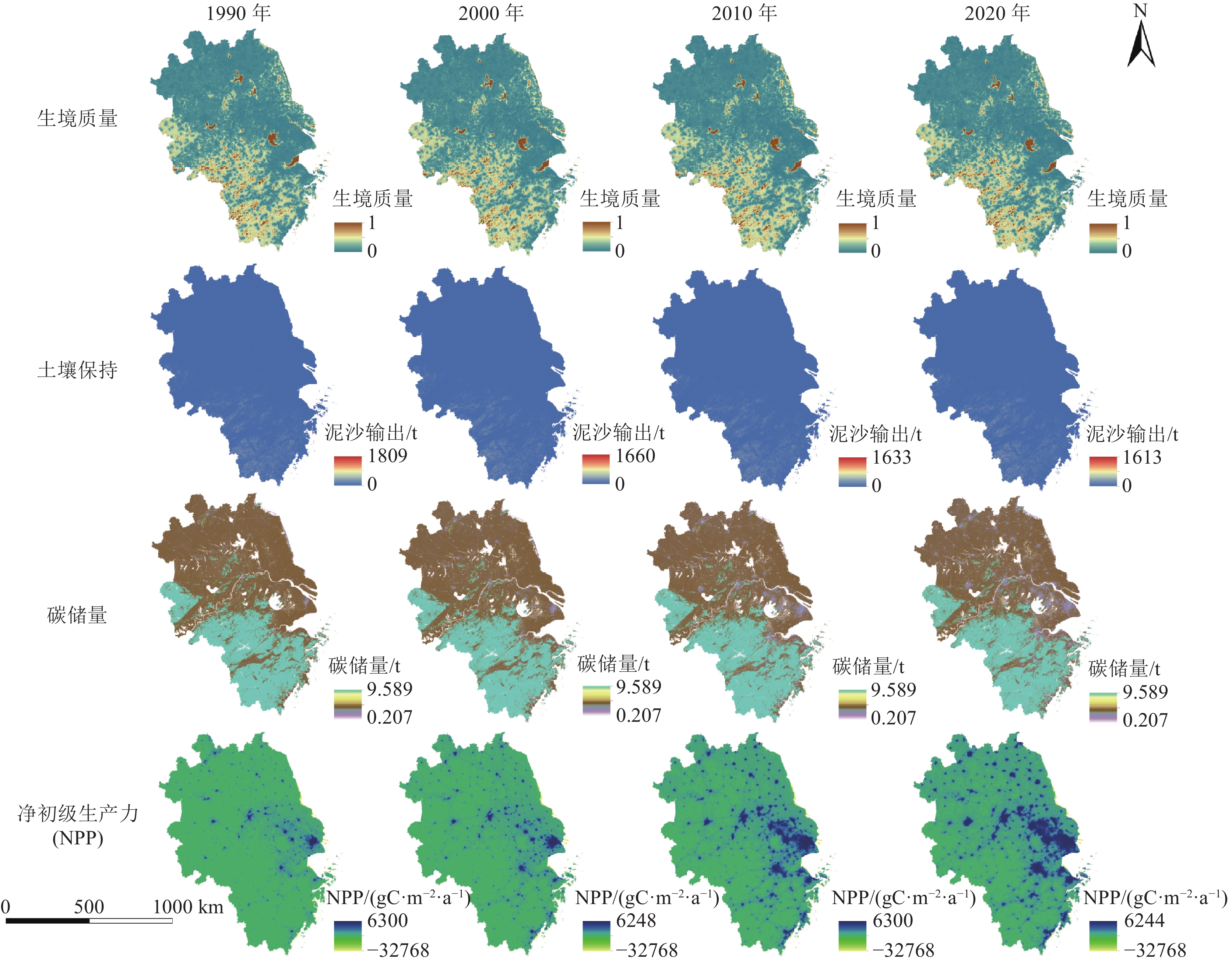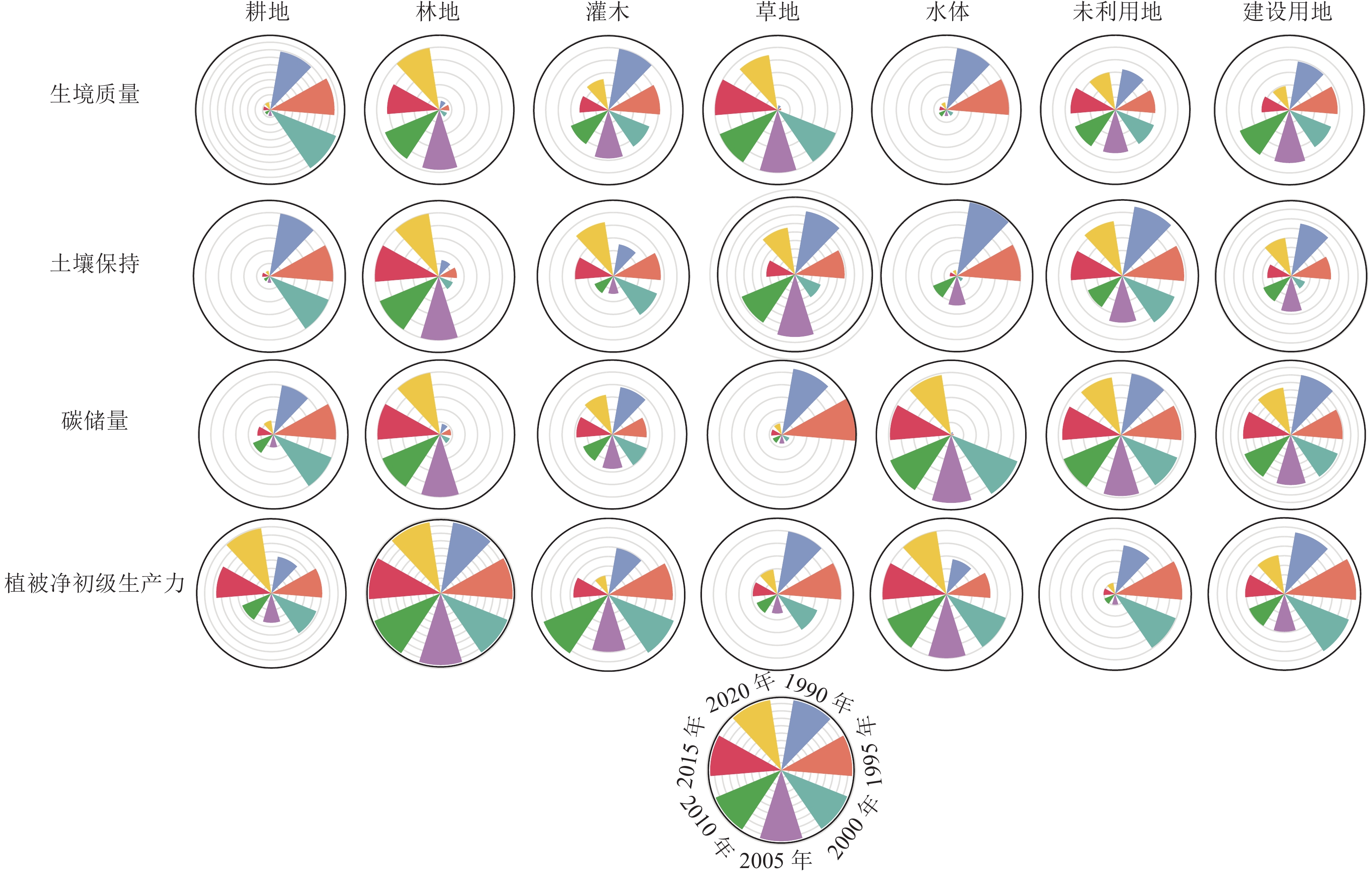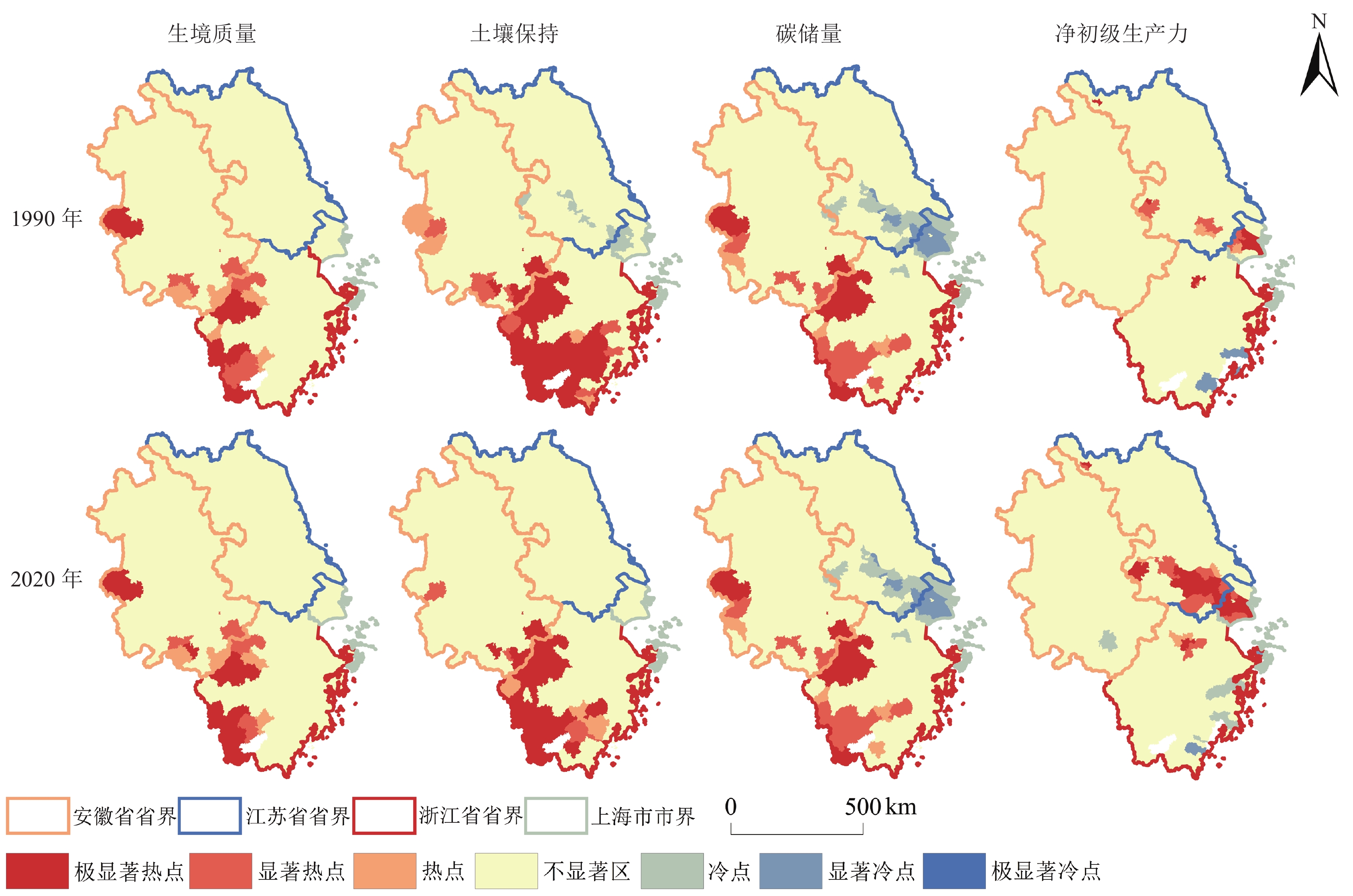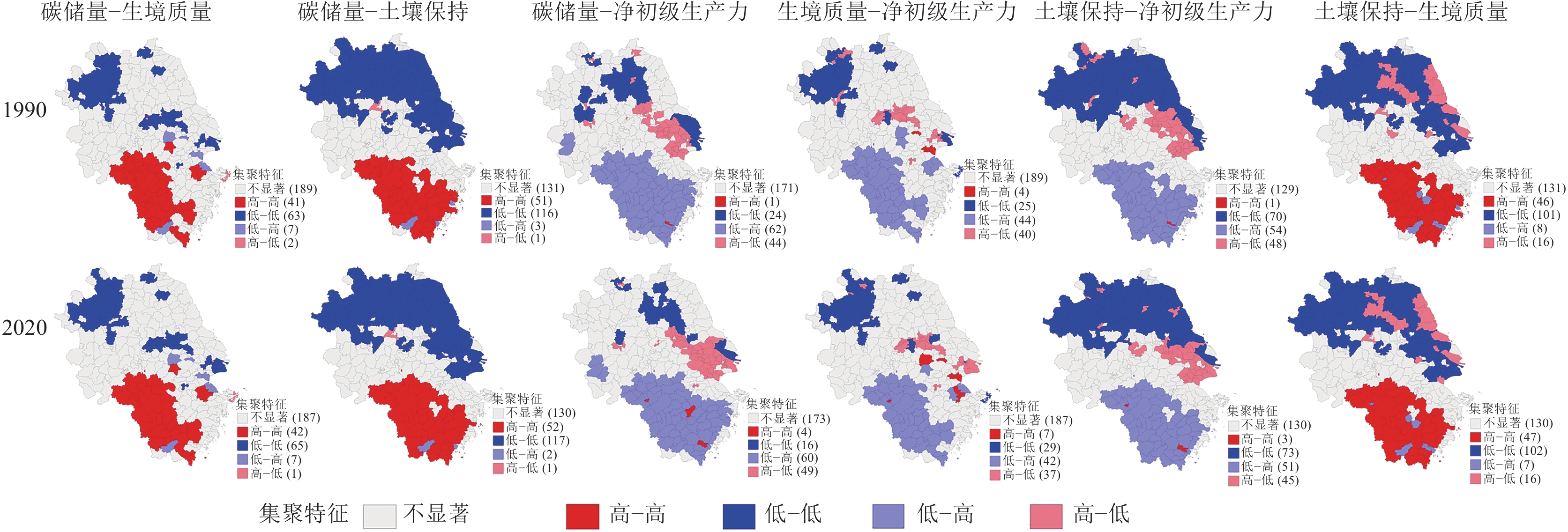Spatial and temporal distribution of ecosystem services and trade-offs in the Yangtze River Delta
-
摘要:研究目的
生态系统服务关系人类福祉,生态系统服务的可持续供给可为区域生态安全和可持续发展提供保障。
研究方法基于InVEST模型,结合土地利用类型、归一化植被指数(Normalized Differnce Vegetation Index, NDVI)和气象数据,分析1990—2020年长江三角洲地区植被净初级生产力(Net Primary Productivity, NPP)、土壤保持、生境质量和碳储量4种重要生态系统服务功能的时空分布特征,并识别其热点区域。采用相关系数法,分析长江三角洲地区不同生态系统服务功能与土地利用类型之间的权衡/协同关系。
研究结果结果表明:①长江三角洲地区的生态系统服务功能具有明显空间异质性,生境质量、水土保持和碳储量呈现出西南高、东北低的空间格局,且生境质量和碳储量的高值沿江分布。1990—2020年,生境质量与碳储量多数提升;土壤保持和植被净初级生产力整体呈现下降趋势,但东部地区有所提高。②1990—2020年,3类热点区(热点区、显著热点区、极显著热点区)所占面积无显著变化,集中分布在西南地区,具有明显的地带性。③土壤保持、碳储量、生境质量之间主要为协同关系,而NPP与碳储量、生境质量、土壤保持主要为权衡关系。为确保当地生态系统的可持续管理,在空间规划中应考虑生态系统服务之间的相互联系,尽量减少权衡效应,提高协同效应。
结论本次研究聚焦于长江三角洲区域,基于ArcGIS和Geoda,通过整合遥感数据、地理信息数据、社会经济数据等多源数据集,对长三角地区的4项关键生态系统服务(固碳能力、土壤保持、生境质量和植被净初级生产力)进行了全面评估,系统地揭示了长三角地区在格网县域尺度上的生态系统服务空间格局特征,为深入理解和优化该区域的生态系统服务提供了重要依据。
Abstract:ObjectiveValuation of ecosystem services is critical to the sustainable development of a region and human well−being.
MethodsTaking the Yangtze River Delta as the study area, we analysed the spatial and temporal distribution characteristics of four important ecosystem service functions, namely, net primary productivity (NPP) of vegetation, soil retention, habitat quality and carbon storage, in the Yangtze River Delta region from 1990 to 2020, based on the InVEST model and combining the land use types, normalised difference vegetation index (NDVI) and meteorological data. The spatial and temporal distribution characteristics of four important ecosystem services, namely vegetation net primary productivity (NPP), soil conservation, habitat quality and carbon storage, were analysed from 1990 to 2020, and hotspot areas for the four ecosystem services were identified. The correlation coefficient method was used to analyze the relationship between various ecosystem functions and land use types in the Yangtze River Delta region.
ResultsThe results show that: ① the ecosystem service functions in the Yangtze River Delta region are spatially heterogeneous, with habitat quality, soil and water conservation and carbon storage showing a spatial pattern of "high in the southwest and low in the northeast", while the high values of habitat quality and carbon storage are distributed along the river. During the period 1990−2020, habitat quality and carbon storage services show a trend of "overall increase − local decrease", while soil conservation and vegetation net primary productivity services show a trend of "overall decrease − local increase". ② The area occupied by the three types of hotspots (hotspots, significant hotspots and very significant hotspots) in the Yangtze River Delta does not change significantly, and the distribution is obviously zonal, concentrated in the southwest. ③ In the Yangtze River Delta, there is a synergistic relationship between soil conservation, carbon storage and habitat, and NPP is a trade−off with carbon storage, habitat quality and soil conservation; among the seven land use types, NPP and soil conservation have a trade−off relationship. The trade−off/synergistic relationship between NPP and soil conservation is consistent with the Yangtze River Delta region. To ensure the sustainable management of local ecosystems, it is necessary to consider the interrelationships among ecosystem services in spatial planning to minimise trade−offs and enhance synergies.
ConclusionsThis study focused on the Yangtze River Delta region and comprehensively evaluated four key ecosystem services (carbon storage, soil retention, habitat quality and net primary productivity of vegetation) in the Yangtze River Delta region through integrating multi−source datasets such as remote sensing data, geographical information data and socio−economic data, based on ArcGIS and Geoda. It systematically revealed the spatial pattern characteristics of ecosystem services in the Yangtze River Delta region on the grid−county scale, providing an important basis for in-depth understanding and optimizing the ecosystem services in this region.
-
Keywords:
- ecosystem services /
- InVEST model /
- trade−off and coordination /
- Yangtze River Delta
创新点分析了1990—2020年长江三角洲地区4种重要生态系统服务功能的时空分布特征及权衡/协同关系,为长江三角洲生态系统服务的动态变化提供科学依据,并有助于制定区域可持续管理政策。
-
-
表 1 数据来源与描述
Table 1 Data source and description
数据类型 数据名称 数据来源 空间分辨率 相关用途 遥感数据 土地利用/覆被数据集:Landsat 8 中国科学院资源环境科学与数据中心
(https://www.resdc.cn/)30 m 土地利用类型 夜间灯光数据集:NPP-VIRS 500 m 生境质量需求 高程数据(DEM)
集:SRTM250 m 土壤保持供给与需求
(地形因子)初级净生产力数据(NPP)集:MOD17A3 https://ladsweb.modaps.eosdis.nasa.gov/ 500 m 归一化植被指数集:MOD13Q1
(NDVI)250 m 人口数据 https://www.worldpop.org/ 1 km 固碳需求 土壤数据 土壤有机质、土壤质地等 HWSD土壤数据库(http://data.tpdc.ac.cn/zh-hans/) 1∶ 1000000 土壤保持供给与需求 气候数据 逐月降水量 中国科学院资源环境科学与数据中心
(https://wwwresdc.cn);
国家青藏高原科学数据中心
(https://data.tpdc.ac.cn/home)1 km 土壤保持供给与需求 二氧化碳排放量 市域尺度 固碳需求 社会经济数据 生物物理表和威胁因素 CHRED 3.0数据库 生境质量供给 其他数据 文献和InVEST用户指南 表 2 长江三角洲各项生态系统服务冷热点空间分布范围及面积占比
Table 2 The proportion of the cold and hot spots ecosystem services in Yangtze River Delta
生态系统服务 1990年热点区(热点、显著热点和极显著热点)占比/% 1990年冷点区(冷点、显著冷点和极显著冷点)占比/% 2020年热点区(热点、显著热点和极显著热点)占比/% 2020年冷点区(冷点、显著冷点和极显著冷点)占比/% 生境
质量11.409 0 11.107 0 土壤
保持19.045 1.886 13.314 0 碳储量 13.340 6.187 13.340 6.187 NPP 2.895 2.133 7.415 3.059 表 3 生态系统服务主成分分析
Table 3 Principal component analysis of ecosystem services
生态系统服务 1990年 2000年 2010年 2020年 成分1 成分2 成分1 成分2 成分1 成分2 成分1 成分2 碳储量 0.721 0.688 0.789 0.608 0.794 0.602 0.804 0.589 生境质量 −0.723 0.691 −0.789 0.612 −0.793 0.607 −0.802 0.594 土壤保持 −0.997 0.061 −0.995 0.088 −0.995 0.091 −0.995 0.098 NPP 0.999 −0.021 0.999 −0.018 0.999 −0.018 0.999 −0.017 解释方差/% 92.084 6.392 85.651 12.714 85.160 13.234 85.071 13.312 -
Anselin L, Syabri I, Smirnov O. 2002. Visualizing multivariate spatial correlation with dynamically linked windows. New tools for spatial data analysis: Proceedings of the specialist meeting[M]. Santa Barbara, University of California.
Bai Y, Zhuang C, Ouyang Z, et al. 2011. Spatial characteristics between biodiversity and ecosystem services in a human−dominated watershed[J]. Ecological Complexity, 8(2): 177−183. doi: 10.1016/j.ecocom.2011.01.007
Chen D, Li J, Yang X, Liu Y, et al. 2018. Trade−offs and optimization among ecosystem services in the Weihe River basin[J]. Acta Ecologica Sinica, 38(9): 3260−3271(in Chinese with English abstract).
Chen W, Liu X, Li H, et al. 2024. Ecosystem service function and security pattern of Tianshan Mountains in Xinjiang from 1990 to 2050[J]. Geology in China, 51(5): 1−22(in Chinese with English abstract).
Cord A, Bartkowski B, Beckmann M, et al. 2017. Towards systematic analyses of ecosystem service trade−offs and synergies: Main concept, methods and the road ahead[J]. Ecosystem Services, 28: 264−272. doi: 10.1016/j.ecoser.2017.07.012
Dai E, Wang X, Zhu J, et al. 2016. Methods, tools and research framework of ecosystem service trade−offs[J]. Geographical Research, 35(6): 1005−1016(in Chinese with English abstract).
Ding Y, Wang L, Gui F, et al. 2023. Ecosystem carbon storage in Hangzhou Bay area based on InVEST and PLUS models[J]. Environmental Science, 44(6): 3343−3352(in Chinese with English abstract).
Egoh B N, Reyers B, Rouget M, et al. 2008. Mapping ecosystem services for planning and management[J]. Agriculture Ecosystems & Environment, 127(1): 135−140.
Fu B, Su C, Wei Y, et al. 2011. Double counting in ecosystem services valuation: causes and countermeasures[J]. Ecol. Res., 26(1): 1−14. doi: 10.1007/s11284-010-0766-3
Fu B, Zhao W, Chen L, et al. 2005. Assessment of soil erosion at large watershed scale using RUSLE and GIS: A case study in the Loess Plateau of China[J]. Land Degradation & Development, 16(1): 73−85.
Guo F, Liu X, Zhang W, et al. 2024. Evolution of the spatial and temporal patterns of habitat quality and analysis of the driving forces in Yellow River Basin (Henan Section) from 2000 to 2040[J]. Geoscience, 38(3): 599−611(in Chinese with English abstract).
He J, Zhuang D. 2006. Analysis of the relationship between urban dynamic change pattern of the Yangtze River Delta and the regional eco−environment[J]. Geographical Research, 3: 388−396,562(in Chinese with English abstract).
Jiang Z, Sun X, Liu F, et al. 2019. Spatio−temporal variation of land us e and ecosystem service values and their impact factors in an urbanized agricultural basin since the reform and opening of China[J]. Environmental Monitoring and Assessment, 191: 1−14. doi: 10.1007/s10661-018-7122-4
Kragt M, Robertson M. 2014. Quantifying ecosystem services trade−offs from agricultural practices[J]. Ecological Economics, 102(2): 147−157.
Lautenbach S, Volk M, Strauch M, et al. 2013. Optimization−based trade−off analysis of biodiesel crop production for managing an agricultural catchment[J]. Environmental Modelling & Software, 48(10): 98−112.
Li J, Li H, Zhang L. 2016. Ecosystem service trade−offs in the Guanzhong−Tianshui economic region of China[J]. Acta Ecologica Sinica, 36(10): 3053−3062(in Chinese with English abstract).
Li P, Jiang L, Feng Z, et al. 2012. Research progress on trade−offs and synergies of ecosystem services: An overview[J]. Acta Ecologica Sinica, 32(16): 5219−5229(in Chinese with English abstract). doi: 10.5846/stxb201109161360
Li S, Zhang C, Liu J, et al. 2013. The tradeoffs and synergies of ecosystem services: Research progress. development trend, and themes of geography[J]. Geographical Research, 32(8): 1379−1390(in Chinese with English abstract).
Li Y, Luo Y, Liu G, et al. 2013. Effects of land use change on ecosystem services: A case study in Miyun reservoir watershed[J]. Acta Ecologica Sinica, 33(3): 726−736(in Chinese with English abstract). doi: 10.5846/stxb201205280787
Liu C, Wang C. 2018. Spatio−temporal evolution characteristics of habitat quality in the loess hilly region based on land use change: A case study in Yuzhong County[J]. Acta Ecologica Sinica, 38(20): 7300−7311(in Chinese with English abstract).
Locatelli B, Imbach P, Wunder S. 2014. Synergies and trade− offs between ecosystem services in Costa Rica[J]. Environmental Conservation, 41(1): 27−36. doi: 10.1017/S0376892913000234
Lyu R, Zhao W, Tian X, et al. 2022. Non−linearity impacts of landscape pattern on ecosystem services and their trade−offs: A case study in the city belt along the Yellow River in Ning xia, China[J]. Ecological Indicators, 136: 108608. doi: 10.1016/j.ecolind.2022.108608
Ma W, Yang F, Wang N, et al. 2022. Study on spatial−temporal evolution and driving factors of ecosystem service value in the Yangtze River Delta Urban Agglomerations[J]. Journal of Ecology and Rural Environment, 38(11): 1365−1376(in Chinese with English abstract).
Meehan T, Gratton C, Diehl E, et al. 2013. Ecosystem−service tradeoffs associated with switching from annual to perennial energy crops in riparian zones of the US Midwest[J]. Plos One, 8(11): 1−13.
Min J, Liu X, Xiao Y, et al. 2024. Analysis and predictions of the spatiotemporal variations of ecosystem carbon storages in the Xin’an river basin based on PLUS and InVEST models[J]. Geoscience, 38(3): 574−588(in Chinese with English abstract).
Ni Z, Yang S, Zhang Q. et al. 2021. Evaluation, trade−off and synergy analysis of ecosystem supply service value in the Yangtze River Delta[J]. Ecological Economy, 37(11): 150−155(in Chinese with English abstract).
Potter C, Randerson J, FieldI C, et al. 1993. Terrestrial ecosystem production: A process model based on global satellite and surface data[J]. Global Biogeochemical Cycles, 7(4): 811−841. doi: 10.1029/93GB02725
Rodriguez J, Beard T, Bennett E, et al. 2006. Trade−offs across space, time, and ecosystem services[J]. Ecology and Society, 11: 28−41.
Ronchi E, Federico A, Musmeci F. 2002. A system oriented integrated indicator for sustainable development in Italy[J]. Ecological Indicators, 2(1/2): 197−210. doi: 10.1016/S1470-160X(02)00045-6
Shan W, Jin X, Ren J, et al. 2019. Ecological environment quality assessment based on remote sensing data for land consolidation[J]. J. Clean Prod., 239: 118126. doi: 10.1016/j.jclepro.2019.118126
Sheng S. 2023. Spatial pattern and driving force of service coordination and tradeoff of coastal ecosystem systems in Shandong[J]. Research on Soil and Water Conservation, 30(2): 384−392.
Su C, Fu B, Wei Y, et al. 2012. Ecosystem management based on ecosystem services and human activities: A case study in the Yan he watershed[J]. Sustainability Science, 7(1): 17−32. doi: 10.1007/s11625-011-0145-1
Sun F, Fang F, Hong W, et al. 2023. Evolution analysis and prediction of carbon storage in Anhui Province based on PLUS and InVEST model[J]. Journal of Soil and Water Conservation, 37(1): 151−158(in Chinese with English abstract).
Sun Q. 2023. The spatial−temporal variation patterns of multiple forest ecosystem services in the Yangtze River basin During 2000−2020[D]. Master’s Thesis of Huazhong Agricultural University: 20−27(in Chinese with English abstract).
Sun Y, Ren Z, Zhao S, et al. 2017. Spatial and temporal changing analysis of synergy and trade−off between ecosystem services in valley basins of Shaanxi Province[J]. Acta Geographica Sinica, 72(3): 521−532(in Chinese with English abstract).
Tian Y. 2018. Study on the synergies and tradeoffs among cultivated land ecosystem services and its management strategies: A case study in Cixi county, Zheiiang Province[D]. Master’s Thesis of Zhejiang University: 29−62(in Chinese with English abstract).
Turner K, Odgaard M, Bocher P, et al. 2014. Bundling ecosystem services in Denmark: Trade−offs and synergies in a cultural landscape[J]. Landscape and Urban Planning, 125(10): 89−104.
Wallace K. 2007. Classification of ecosystem services: Problems and solutions[J]. Biological Conservation, 139(3/4): 235−246. doi: 10.1016/j.biocon.2007.07.015
Wang B, Zhao J, Hu X. 2018. Analysison trade−offs and synergistic relationships among multiple ecosystem services in the Shiyang River Basin[J]. Acta Ecologica Sinica, 38(21): 7582−7595(in Chinese with English abstract).
Wang H, Wang L, Fu X, et al. 2022. Spatial−temporal pattern of ecosystem service supply−demand and coordination in the Ulansuhai Basin, China[J]. Ecological Indicators, 143: 109406. doi: 10.1016/j.ecolind.2022.109406
Wang P, Zhang L, Li Y, et al. 2017. Spatio−temporal characteristics of the trade−off and synergy relationships among multiple ecosystem services in the upper reaches of Hanjiang River Basin[J]. Acta Geographica Sinica, 72(11): 2064−2078(in Chinese with English abstract).
Wu N, Chen N, Cheng P, et al. 2023. Evaluation of carbon storage on terrestrial ecosystem responses to land cover change under five future scenarios in Anhui Province[J]. Resources and Environment in the Yangtze, 32(2): 415−426(in Chinese with English abstract).
Wu Q. 2024. Ecosystem services supply−demand pattern, influencing factors and optimal management strategy at multi−scale in the Yangtze River Delta[D]. Master’s Thesis of Zhejiang University: 25−27(in Chinese with English abstract).
Wu W, Peng J, Liu Y, et al. 2017. Tradeoffs and synergies between ecosystem services in Ordos City[J]. Progress in Geography, 36(12): 1571−1581(in Chinese with English abstract). doi: 10.18306/dlkxjz.2017.12.012
Xu L, Huang Q, Ding D, et al. 2018. Modelling urban expansion guided by land ecological suitability: A case study of Changzhou City, China[J]. Habitat International, 75: 12−24. doi: 10.1016/j.habitatint.2018.04.002
Yang X, Li J, Qin K, et al. 2015. Trade−offs between ecosystem services in Guanzhong−Tianshui Economic Region[J]. Acta Geographica Sinica, 70(11): 1762−1773(in Chinese with English abstract).
Yuan J, Liu X, Li H, et al. 2024. Spatial and temporal variability of carbon stocks in different land−use types in the Yiluo River Basin in the middle section of the Yellow River from 1990 to 2050[J]. Geoscience, 38(3): 559−573(in Chinese with English abstract).
Zhang D, Sun X, Yuan X, et al. 2018. Land use change and its impact on habitat quality in Lake Nansi Basin from 1980 to 2015[J]. Journal of Lake Sciences, 30(2): 349−357(in Chinese with English abstract). doi: 10.18307/2018.0207
Zhang M, Wang K, Liu H, et al. 2018. Effect of ecological engineering projects on ecosystem services in a karst region: A case study of northwest Guangxi, China[J]. Journal of Cleaner Production, 183: 831−842. doi: 10.1016/j.jclepro.2018.02.102
Zhang Y, Lu X, Liu B, et al. 2021. Spatial relationships between ecosystem services and society ecological drivers across a large−scale region: A case study in the Yellow River Basin[J]. Science of the Total Environment, 766: 142480. doi: 10.1016/j.scitotenv.2020.142480
Zhang Z, Tu Y, Li X. 2016. Quantifying the spatiotemporal patterns of urbanization along Urban−RuralGradient with a roadscape transect approach: A case study in Shanghai, China[J]. Sustainability, 8(9): 1−19.
Zheng Z, Fu B, Hu H, et al. 2014. A method to identify the variable ecosystem services relationship across time: A case study on Yanhe Basin, China[J]. Landscape Ecology, 29(10): 1689−1696. doi: 10.1007/s10980-014-0088-x
Zhou J, Zhang X, Mu F, et al. 2018. Spatial pattern reconstruction of soil organic carbon storage based on CA−Markov−A case study in Pan−Yangtze River Delta[J]. Resources and Environment in the Yangtze, 27(7): 1565−1575(in Chinese with English abstract).
Zhu Y, Wu H, Ma M, et al. 2024. Multi−scale spatial relationship between carbon emissions and influencing factors in the Yangtze River Delta[J]. Geological Bulletin of China, 43(7): 1−10(in Chinese with English abstract).
陈登帅, 李晶, 杨晓楠, 等. 2018. 渭河流域生态系统服务权衡优化研究[J]. 生态学报, 38(9): 3260−3271. 陈武迪, 刘晓煌, 李洪宇, 等. 2024. 新疆天山1990—2050年生态系统服务功能及安全格局[J]. 中国地质, 51(5): 1−22. 戴尔阜, 王晓莉, 朱建佳, 等. 2016. 生态系统服务权衡: 方法、模型与研究框架[J]. 地理研究, 35(6): 1005−1016. 丁岳, 王柳柱, 桂峰等. 2023. 基于InVEST模型和PLUS模型的环杭州湾生态系统碳储量[J]. 环境科学, 44(6): 3343−3352. 郭富印, 刘晓煌, 张文博, 等. 2024. 2000—2040年黄河流域(河南段)生境质量时空格局演变及驱动力分析[J]. 现代地质, 38(3): 599−611. 何剑锋, 庄大方. 2006. 长江三角洲地区城镇时空动态格局及其环境效应[J]. 地理研究, 3: 388−396,562. doi: 10.3321/j.issn:1000-0585.2006.03.003 李晶, 李红艳, 张良. 2016. 关中—天水经济区生态系统服务权衡与协同关系[J]. 生态学报, 36(10): 3053−3062. 李鹏, 姜鲁光, 封志明, 等. 2012. 生态系统服务竞争与协同研究进展[J]. 生态学报, 32(16): 5219−5229. 李双成, 张才玉, 刘金龙, 等. 2013. 生态系统服务权衡与协同研究进展及地理学研究议题[J]. 地理研究, 32(8): 1379−1390. 李屹峰, 罗跃初, 刘纲, 等. 2013. 土地利用变化对生态系统服务功能的影响: 以密云水库流域为例[J]. 生态学报, 33(3): 726−736. 刘春芳, 王川. 2018. 基于土地利用变化的黄土丘陵区生境质量时空演变特征——以榆中县为例[J]. 生态学报, 38(20): 7300−7311. 马伟波, 杨帆, 王楠, 等. 2022. 长江三角洲城市群地区生态系统服务价值时空演变及驱动因素研究[J]. 生态与农村环境学报, 38(11): 1365−1376. 闵婕, 刘晓煌, 肖粤新, 等. 2024. 基于PLUS模型和InVEST模型的新安江流域生态系统碳储量时空变化分析与预测[J]. 现代地质, 38(3): 574−588. 倪泽睿, 杨上广, 张全. 2021. 长江三角洲城市群地区生态系统供给服务价值评估及权衡协同分析[J]. 生态经济, 37(11): 150−155. 孙方虎, 方凤满, 洪炜林等. 2023. 基于PLUS和InVEST模型的安徽省碳储量演化分析与预测[J]. 水土保持学报, 37(1): 151−158. 孙琪. 2023. 2000−2020年间长江流域森林生态系统多重服务的时空变异规律[D]. 华中农业大学硕士学位论文: 20−27. 孙艺杰, 任志远, 赵胜男, 等. 2017. 陕西河谷盆地生态系统服务协同与权衡时空差异分析[J]. 地理学报, 72(3): 521−532. doi: 10.11821/dlxb201703012 田榆寒. 2018. 耕地生态系统服务协同与权衡关系及管理策略——以慈溪市为例[D]. 浙江大学硕士学位论文: 29−62. 王蓓, 赵军, 胡秀芳. 2018. 石羊河流域生态系统服务权衡与协同关系分析[J]. 生态学报, 38(21): 7582−7595. 王鹏涛, 张立伟, 李英杰, 等. 2017. 汉江上游生态系统服务权衡与协同关系时空特征[J]. 地理学报, 72(11): 2064−2078. doi: 10.11821/dlxb201711011 吴楠, 陈凝, 程鹏等. 2023. 安徽省陆地生态系统碳储量变化对未来土地覆被情景的响应[J]. 长江流域资源与环境, 32(2): 415−426. 吴卿. 2024. 长三角生态系统服务多尺度供需格局、影响因素与优化管理策略[D]. 浙江大学硕士学位论文: 25−27. 武文欢, 彭建, 刘炎序, 等. 2017. 鄂尔多斯市生态系统服务权衡与协同分析[J]. 地理科学进展, 36(12): 1571−1581. 杨晓楠, 李晶, 秦克玉, 等. 2015. 关中—天水经济区生态系统服务的权衡关系[J]. 地理学报, 70(11): 1762−1773. doi: 10.11821/dlxb201511006 袁江龙, 刘晓煌, 李洪宇, 等. 2024. 1990−2050年黄河中游伊洛河流域不同土地利用类型碳储量时空分异特征[J]. 现代地质, 38(3): 559−573. 张大智, 孙小银, 袁兴中, 等. 2018. 南四湖流域1980—2015年土地利用变化及其对流域生境质量的影响[J]. 湖泊科学, 30(2): 349−357. doi: 10.18307/2018.0207 周杰, 张学儒, 牟凤云, 等. 2018. 基于CA−Markov的土壤有机碳储量空间格局重建研究——以泛长三角地区为例[J]. 长江流域资源与环境, 27(7): 1565−1575. 朱一姝, 吴涵宇, 马明, 等. 2024. 长江三角洲城市群碳排放及其影响因素的多尺度空间关系研究[J]. 地质通报, 43(7): 1−10.




 下载:
下载:




